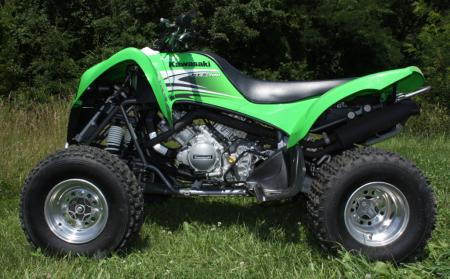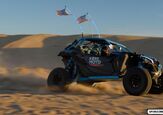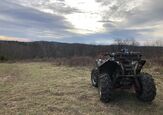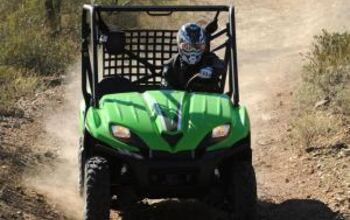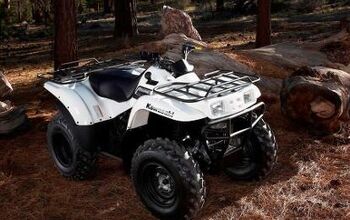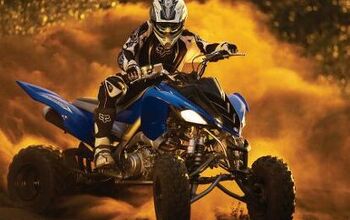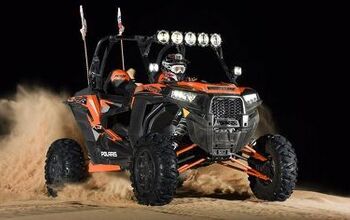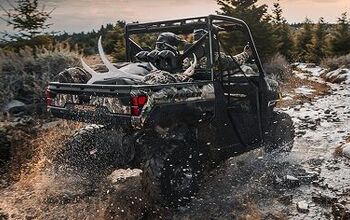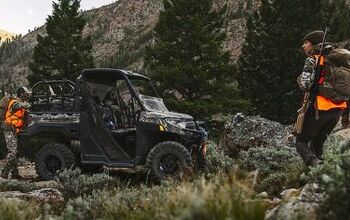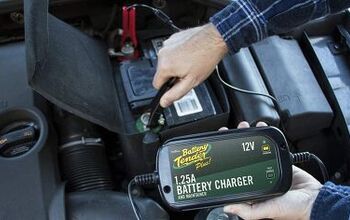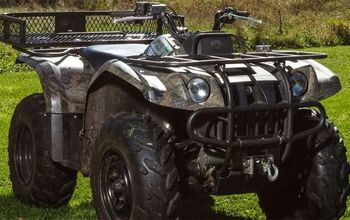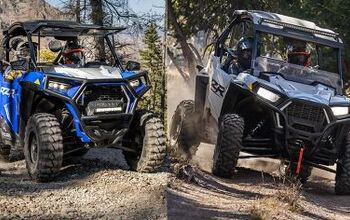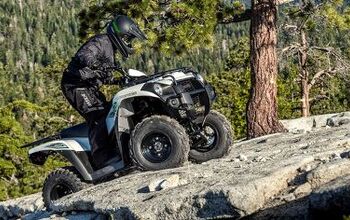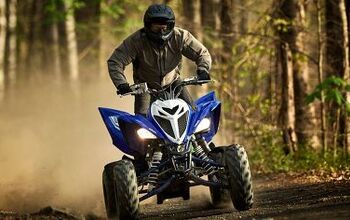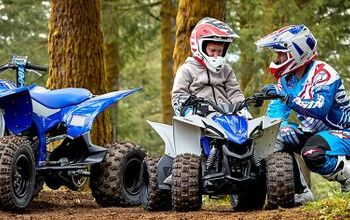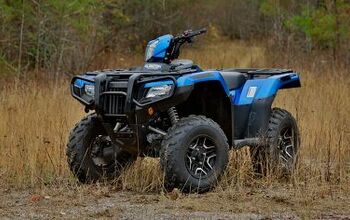2009 Kawasaki KFX700 Review
Kawasaki‘s KFX700 is a very unique sport ATV. Part drag racer and part easy-going cruiser, the KFX is the ATV for the trail rider who likes to ride fast with the least amount of work.
Part utility machine, the KFX700 borrows its engine and shaft drive rear end from Kawasaki’s Brute Force line of 4×4 sport Utility machines. The engine received a number of changes to increase its sporting performance. From there the machine received an all new chassis and front end with dual A-arms instead of the McPherson struts found on the Brute Force utility quads.
The V-Twin engine displaces 697cc. Each cylinder features four valves actuated by single overhead cams. The engine is fed its diet of air and fuel by dual Keihin 32mm carburetors and spent fuel is channeled out by dual headers into a single large steel bodied spark arrested silencer.
The KFX700 is a sporty trail machine with utility lineage.
A fully automatic CVT transmission features forward, neutral, and reverse settings which are selected by a unique twist selector mounted on the left side of the handlebar. You shift between the gears by pressing down on the rear brake, depressing the button on the selector and twisting it forward or backward. We like that the selector is more low profile than on most utility 4x4s, but it is a bit notchy to operate if you aren’t deliberate in your movement.
We found the powerful V-Twin was happiest when we turned it loose.
As you would expect the V Twin engine is very powerful, however it isn’t overwhelming. From a dead stop you can accelerate away as slow and smoothly or as abruptly as you would like. Power is always available from the holeshot to top speed. Down low torque is smooth and abundant. Punch the gas out of corners and V-Twin springs up with a surge of midrange muscle that can easily raise the front end of the 550-pound machine. At high RPMs in wide open spaces the engine remains responsive. It’s here where the KFX feels most at home as it prefers being pushed hard.
With so much torque on hand the engine can also be extremely effective on tight trails, but we noticed it running a bit hotter in the hands of less experienced pilots who don’t keep the juices flowing in the mid to upper RPMs.
The CVT transmission plays a big role in the effectiveness of the engine. When you hit the gas there is little sensation of lag from the transmission. The tranny engages low in the RPMs, allowing you to putt along the trail with the throttle barely cracked open. When racing in and out of corners the transmission back-shifted predictably and kept us in the meat of the powerband.
Even with more than nine inches of travel up front and eight inches in the rear, the KFX700 offers a fairly firm and sporty ride.
Its dual A-arm front end is equipped with preload adjustable shocks that control 9.25 inches of suspension travel. The rear end features a linkageless design and a single preload and compression adjustable shock which controls 7.9 inches of travel. The front end of the chassis features a single lower frame spar mounting the lower A-arms as close together as possible to minimize bump steer.
The KFX trades in the plush ride of the Brute Force for a firmer one with less body roll. Although the KFX could be a great casual trail cruiser, its shocks are a bit stiff for in-the-saddle rides across rough roots and rocks. Pick yourself out of the saddle and pick up the speeds and things seem to work better. We found the KFX suspension works better if you bounce across the tops of roots and rough trail sections rather then drive trough them.
With so much power on tap it is easy to catch air on the KFX and it does well on most natural obstacles you encounter on the trail. We wouldn’t recommend it for the motocross track due to its weight, but lunatics can catch big air on jumps with smooth landings. Howeve, if you come up short on a sizable double with the big KFX you’ll pay a price. Widely spaced rollers are fun, but the rear shock packs if the whoops get too deep. With it being more of a trail machine we softened the preload up all the way making the ride as plush and forgiving as possible.
Getting the front wheels off the ground is child’s play.
The KFX700 sits 47 inches wide with a 33.5-inch seat height. To help lower its center of gravity Kawasaki mounted its 3.2-gallon fuel tank under the seat .
Despite its hefty weight the KFX feels surprisingly nimble. With its low rear mounted fuel tank combined with high traction 22-inch ITP Holeshot tires mounted on reinforced aluminum wheels, the KFX is a blast to wheelie across fields. It is also easy to raise the front wheels for trail obstacles thanks in part to the 700’s fast reacting CVT transmission. Despite its light front end the machine responds well to rider positioning, which keeps the front end manageable on steep climbs.
ITP’s Holeshot tires provide impressive performance.
Steering on the KFX is lighter and faster then you would expect on a machine of this weight. The 700 goes where it is pointed as long as you don’t overdrive the front end with the throttle. In high traction conditions the KFX likes to be driven through the turns with the rear wheels hooked up as it will two-wheel before the rear wheels break loose. In loose, muddy or grassy conditions the KFX is a capable slider, but be aware it can get tippy if traction becomes available mid turn. Racing down high speed straights the front feels just a bit busy. It’s not hard to keep the KFX shooting straight, as long as the terrain isn’t extremely whooped out.
The ITP tires make the most of the KFX’s two-wheel drive, providing predictable traction in a wide variety of conditions. Of course, the shaft drive doesn’t allow you to re-gear the machine after a tire swap, which makes the stock tires one of the best options.
The KFX is slowed by dual hydraulic disc brakes up front and Kawasaki’s sealed multi disc brake system in the rear. The sealed rear brake was borrowed along with the rear swingarm and drive shaft from the Brute Force 650. This rear brake helps maintain 6.3 inches of ground clearance in the rear and never allows the rear brake to come in contact with mud or rocks, virtually eliminating the need to work on the rear brake. Engine braking is available, however it only works after the throttle is chopped while the engine’s RPMs decrease, or if you keep the throttle cracked on descents.
Engine braking will help slow the big sport quad down on descents, but the throttle must be engaged.
We wish the big Kawi offered a more traditional engine braking system that would help slow the machine without the throttle being engaged. It is challenging for beginners to apply the gas while traversing long descents. Our experienced test rider, Aaron Meyer, actually prefers the way the engine braking works on the KFX as he felt it better allowed him to moderate the speed.
We’ve got no complaints with the brakes on the KFX as both ends offer a good amount of stopping power. The front brakes offer excellent feel while the rear brakes feel a bit less solid at the lever. However, what the multi disc rear brake lacks in feel it makes up for with power and durability.
As the KFX’s design appeals to riders of different skill levels, its ergonomics also fit a variety of riders. While it is a large machine, it will fit most riders over five-feet tall pretty comfortably. Unlike some large bore CVT equipped ATVs the KFX’s midsection feels reasonably narrow. The seat is super long and comfortable, its handlebar bend feels good and the relationship between the seat, bars and pegs feels good on long rides.
After riding the KFX for a few months there is no denying its fun factor that is perhaps enhanced by its simplicity of operation. It’s a fast trail machine that excels in wide open spaces that could be easily turned into either the ultimate trail cruiser or GNCC racer with a few mods.
If you are not a serious mud runner, like to ride fast on the trail but don’t want to worry about gear selection or slipping the clutch than the KFX700 could be a good machine for you.
If you’re looking for an easy-to-use, sporty trail tamer, the powerful KFX700 certainly fits the bill.
Editor’s Note: Kawasaki has discontinued the KFX700. However, while no new models are being built, dealerships still have them in stock and you can find plenty of used models if you’re willing to look around. Check out our classifieds section and see for yourself.
Comparable Vehicles: Yamaha Raptor 700R, Honda TRX700XX, Can-Am Renegade 800R EFI, Can-Am Renegade 500 EFI
Related Reading
More by ATV.com Staff



